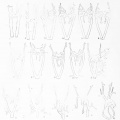File:Congdon1922-1-16.jpg

Original file (980 × 1,000 pixels, file size: 157 KB, MIME type: image/jpeg)
Figs. 1 to 16. Ventral views of aortic-arch system
Showing successive developmental stages. In the earliest stage only the first arch is present, while in the last (a full-term fetus) the vessels have acquired nearly their adult form. The so-called fifth arch is indicated by asterisk.
|
- Human Aortic Arch 1922: Table 1 | Fig. 1-16 | Fig 17 | Fig 18-25 | Fig 18 | Fig 19 | Fig 20 | Fig 21 | Fig 22 | Fig 23 | Fig 24 | Fig 25 | Fig 26 | Fig 27-28 | Fig 29 | Fig 30 | Fig 31 | Fig 32 | Fig 33 | Fig 34 | Fig 35 | Fig 36 | Fig 37 | Fig 38 | Fig 39 | Fig 40 | Plate 1 | Plate 2 | Plate 3 | Carnegie No.68 | Volume XIV | Contributions to Embryology | Historic Disclaimer | Cardiovascular Development | Respiratory Development
Reference
Congdon ED. Transformation of the aortic-arch system during the development of the human embryo. (1922) Contrib. Embryol., Carnegie Inst. Wash. Publ 277, 14:47-110.
Cite this page: Hill, M.A. (2024, April 27) Embryology Congdon1922-1-16.jpg. Retrieved from https://embryology.med.unsw.edu.au/embryology/index.php/File:Congdon1922-1-16.jpg
- © Dr Mark Hill 2024, UNSW Embryology ISBN: 978 0 7334 2609 4 - UNSW CRICOS Provider Code No. 00098G
| Historic Disclaimer - information about historic embryology pages |
|---|
| Pages where the terms "Historic" (textbooks, papers, people, recommendations) appear on this site, and sections within pages where this disclaimer appears, indicate that the content and scientific understanding are specific to the time of publication. This means that while some scientific descriptions are still accurate, the terminology and interpretation of the developmental mechanisms reflect the understanding at the time of original publication and those of the preceding periods, these terms, interpretations and recommendations may not reflect our current scientific understanding. (More? Embryology History | Historic Embryology Papers) |
File history
Click on a date/time to view the file as it appeared at that time.
| Date/Time | Thumbnail | Dimensions | User | Comment | |
|---|---|---|---|---|---|
| current | 08:22, 1 September 2012 |  | 980 × 1,000 (157 KB) | Z8600021 (talk | contribs) | |
| 17:49, 7 May 2011 |  | 888 × 891 (74 KB) | S8600021 (talk | contribs) | ==Figs. 1 to 16. Ventral views of aortic-arch system== Showing successive developmental stages. In the earliest stage only the first arch is present, while in the last (a full-term fetus) the vessels have acquired nearly their adult form. The so-called f |
You cannot overwrite this file.
File usage
The following page uses this file:
